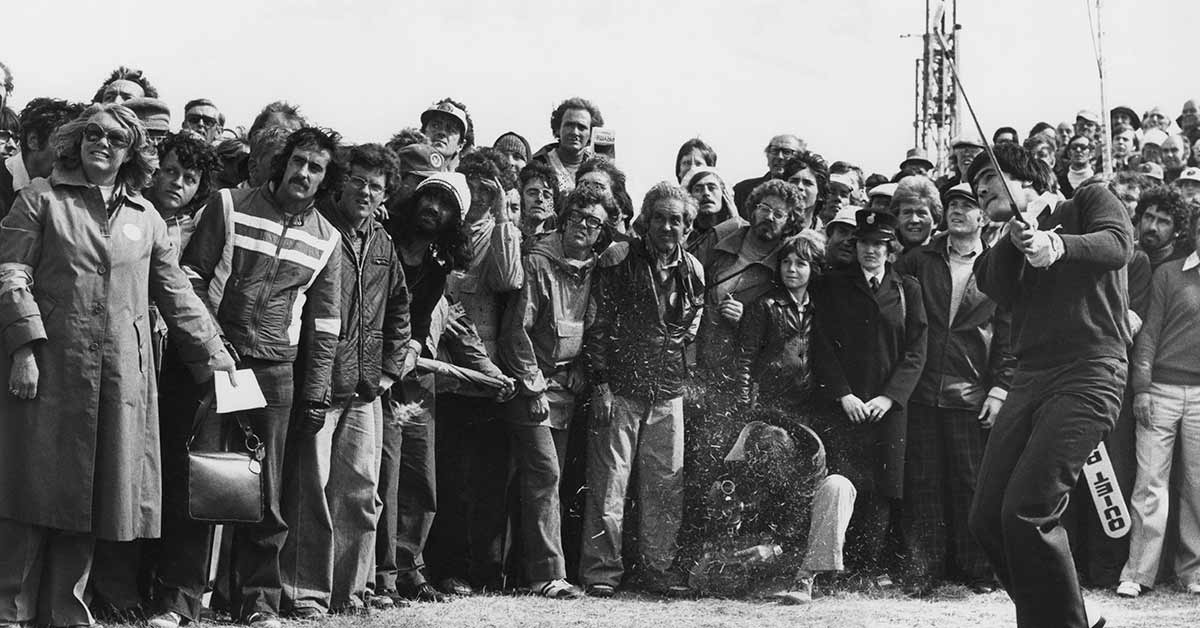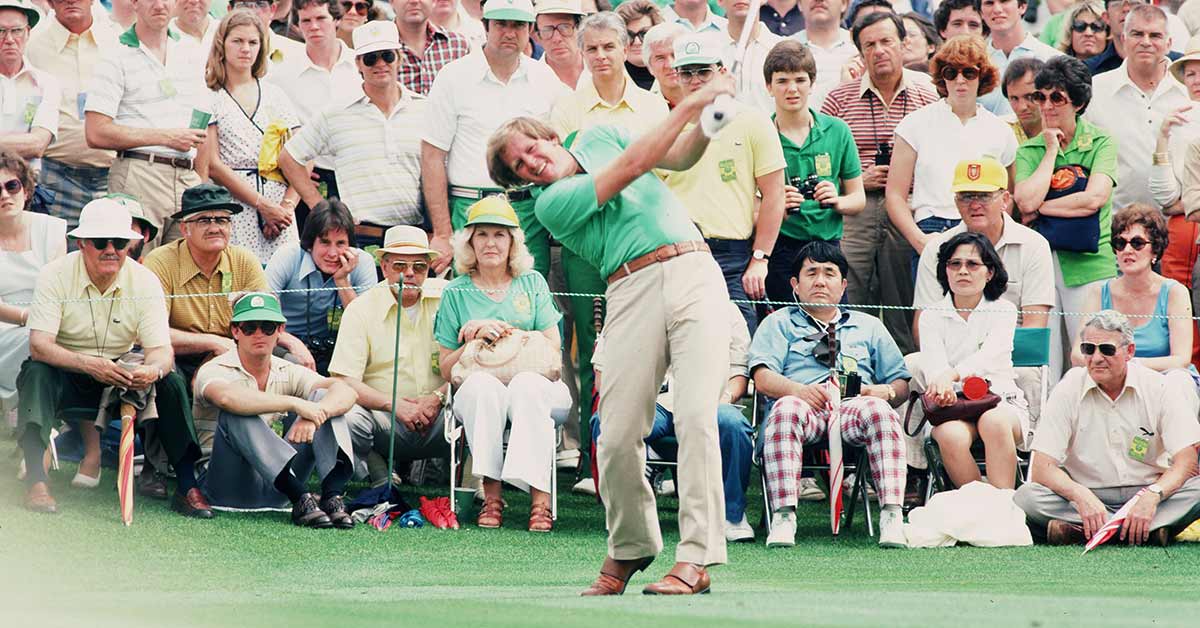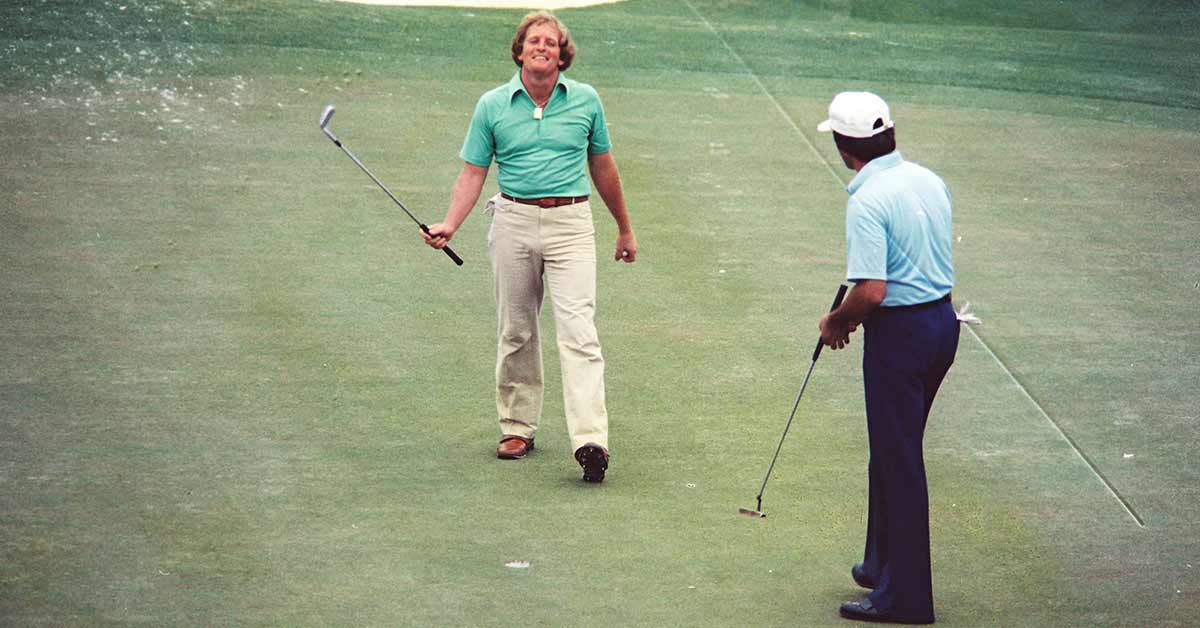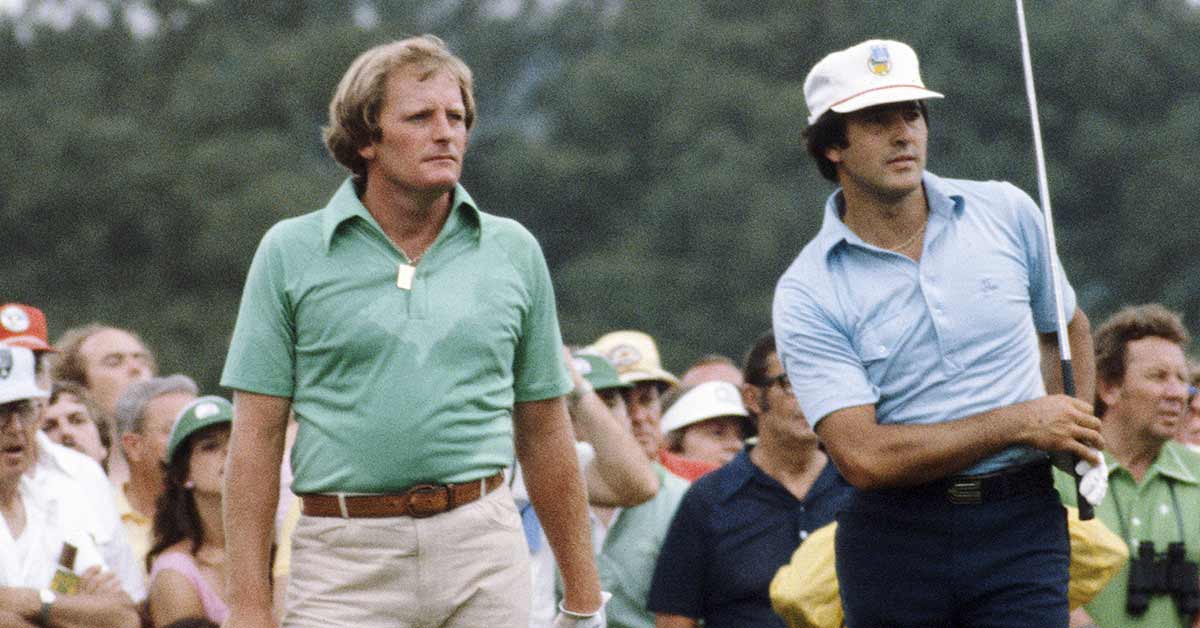Australian golf’s leading commentator, Jack Newton, celebrates the brilliant career of Seve Ballesteros. Newton also suggests how golf’s rulemakers could revive shot-making in today’s power game.
This is part of a series marking the 50th anniversary of Australian Golf Digest and commemorating the best literature we’ve ever published. Each entry includes an introduction that celebrates the author or puts in context the story.
It’s hard enough remembering something that took place 40 years ago, let alone having to wrack your brains while suffering from Alzheimer’s disease. Yet for Aussie icon Jack Newton, the drama that unfolded on a Sunday afternoon at Augusta National in April 1980 remains as clear today as it did in the moment.
This year marks four decades since Newton almost did the unthinkable and reined in a swashbuckling Seve Ballesteros to become Australia’s first Masters champion.
For three days the young Spanish superstar made Augusta National his own personal playground, carving and curving shots in all directions to set up a seemingly insurmountable seven-shot lead after 54 holes. But, as we know, no lead is safe around that place come Sunday on the back nine – just ask Greg Norman.
Paired together for the final round, the result looked beyond doubt when Seve birdied three of the opening five holes to extend his gap over Newton to 10. But the tournament was flipped on its head when they arrived at Amen Corner. After taking bogey at 10, Seve dunked balls in the water at 12 and 13 to make double-bogey, bogey, while Newton went on a tear, birdieing the 11th, 12th and 13th to cut the margin back to three shots.
But Seve steadied the ship with a birdie at 15, while Newton rued missed chances virtually the whole way home, including a costly three-putt par on 15 that ultimately sealed his fate.
“Heading into that final round I had a mindset to push Seve as hard as I could,” Newton recalled to Australian Golf Digest over a Zoom chat last month. “I did get close to him for a moment there and it was a lot of fun.
“I remember after we went through Amen Corner, all I could hear was Seve effing and blinding to himself on the 14th tee. I asked him what he was carrying on about and he said he was just going over his blowouts over the previous few holes. I said, ‘You’ll have to wipe it off and move on,’ and, to his credit, he did just that and went on to win by four shots.
“He was a good bloke, Seve. I never had any complaints or regrets about him. At the end of the day I was happy I finished the tournament well. Seve was always a dangerous player to come up against because he could produce golf shots nobody else could.”
Shot-making, “si”. His English? Not so flash.
“He always called me ‘Yak’,” Newton laughs. “But I always knew when he was in a bad mood because I could make out the swear words in Spanish pretty easily.”
To help mark the 40th anniversary of their 1980 showdown, we revisit one of Newton’s mot telling contributions to our magazine. Written with long-time senior writer Rohan Clarke, Newton’s analysis of his great mate Seve appeared in our October 2007 edition, not long after Seve retired from competitive golf. What makes it so timely, apart from reliving the remarkable talent of Seve, are Newton’s unanswered cries for golf’s rulemakers to make a stand against technology, which he believed was robbing the game of the true art of shot-making, and its next generation of Severianos.
Sadly, that void remains. – Brad Clifton

Few golfers have had greater influence on the game of golf than Seve Ballesteros. His retirement this year brings to an end one of the most brilliant careers. Ballesteros won five Majors and 94 professional tournaments. More importantly, Seve helped to shift the balance of power in golf away from America towards Europe. There can be no greater influence on the Ryder Cup than Ballesteros, who almost single-handedly revived that contest.
Ballesteros, who turned 50 on April 9, will always be remembered for what he brought to the game as one of the great shot-makers. I feel for the younger generation of TV viewers that never got to see Seve in his prime. I would hate to think they might remember him as someone who struggled to break 80 in the latter part of his career.
Seve was an enigma. Because of his Latin temperament, he had that bit of fire in the belly that made people love watching him play. He was a long hitter in his day and flamboyant. If he hit a wild shot off the tee, people enjoyed seeing Seve try to get himself out of trouble. And he was a freak at it.
When Seve walked on the golf course he stood out like Greg Norman and Jack Nicklaus. He was famous for his stare, which would make lesser players crumble. Similarly, Seve polarises people. He has got very staunch supporters in Europe but there are those that will point the finger at him and say he’s surly and had too much influence.
I knew Seve quite well. He came onto the professional scene in 1974 when I was playing in Europe. In those early days, he asked me to go and have a look at his swing. (I felt the only time Seve struggled was when he got across the line at the top of his backswing. And, sometimes, that caused him to stay back and either push the ball or hook it with the overuse of his hands.) So I used to have quite a bit to do with him. When he went to the United States, he used to regularly have dinner with my wife Jackie and I.

It’s well documented that Seve was not a big fan of Americans and America, in general. Perhaps it was a little bit of the stigma from the ‘Old Gringo’ days when foreigners, especially Mexicans, were shunned. (In the early 1980s, Seve insisted that he shouldn’t be required to play 15 tournaments to keep his PGA Tour card, since Nicklaus only had to play about seven or eight events. Seve refused to play the minimum 15 and, after having a huge blue with then-tour commissioner Deane Beman, subsequently lost his card.)
Regardless, I don’t think the Americans ever rated him as highly as he should have been. I can remember at Greensboro in 1978, the week before the Masters, Seve had just started playing in America for the odd tournament apart from the Majors. He was seeking to get his tour card and play there full-time. I vividly remember a discussion going on in the locker room. Seve had shot 76 in the first round and there was a few snide comments that he wasn’t that good. Then Seve put together three incredible rounds to win the golf tournament quite handsomely. To some of the Americans who were around on the Sunday afternoon, I said, “I think you’ve under-rated this fellow a bit. He can play, don’t worry about that.”
Talk in the locker-room changed a little bit afterwards. You would hear the odd remark like, “Here comes the Spaniard to take our money.” But it still took more time for Seve to begin to be appreciated. I recall the Masters at Augusta in 1979 when we were both in contention, eventually tieing for 12th. One of the American journos asked me, “What about this kid, Ballastinos or something. What’s his name?”
And I said, “Well, you better learn how to spell it. Because he’s going to be around for a while and he’s going to win a lot of tournaments. And big ones.”
In 1980, Seve won his first Masters, beating me by four strokes.

The most innovative shot-maker I’ve ever seen
It was often said about Seve that you don’t have to worry about him when he’s on the fairway; it’s when he’s off the fairway that you have to be concerned. That originated from the 1979 British Open at Royal Lytham where he made a miraculous recovery to save par from a temporary carpark and went on to win his first Major at the age of 22.
If he’s not the best shot-maker, Seve is certainly the most innovative shot-maker I’ve seen. I would put him and Lee Trevino on a different level to everyone else. Gary Player was a great bunker player but those two had all the shots, particularly out of trouble. They seemed to be able to invent a shot. Trevino, for example, invented the greenside shot through the fringe with the sole of the sand iron to make the ball come out with topspin. (I’ve also seen Trevino hit a bunker shot with a 9-iron from a fried-egg lie. With no green to play with, he was able to stop it on a downslope to a pin cut less than four metres from the edge of the bunker. Tom Watson and I were gobsmacked.)
I remember a shot that Seve played at Royal Melbourne one year. He was in the first bunker on the 14th hole of the old Composite layout, a par 5 that doglegs to the right. In that bunker on the left, he hit it off his knees about 40 metres, over the greenside bunker, to about eight feet from the pin. With ti-tree entering his back swing as well! And that’s where he was phenomenal.
What is often overlooked is that Seve was a very good putter in those early days. At times, you could suggest that his putting made his short game look good. But I think one sort of complemented the other – when you put the combination of a freakish uninhibited short game like he had with the ability to get the ball in the hole like he did.
I think a big reason for Seve’s unique ability and creativity was that he learned the game while playing around the beaches near his home in Pedrena, Cantabria, Spain. He mainly used a 3-iron that was given to him by one of his older brothers. Both Seve and Ireland’s Christy O’Connor were what you might call ‘handsy’ players by modern-day standards. They had incredible ‘hands’. Incidentally, Christy learned to play on a beach near Dublin where he used to practise by hitting 2-irons off the sand. With the wind as a contributing factor, they both learned to manufacture shots.
It’s an incredible thing to watch a handsy player because they have great timing and great feel to play the shot required. What they see in their mind, they also have the ability to execute under pressure. It’s all very well to practise those shots, but you’ve got to have the self-belief, and the ability to see the shot and pull it off under pressure. That’s the difference between a great player and a manufactured player.
However, with a lot of modern teaching, one of the main pushes has been to eliminate the use of the hands. I’m not sure that eliminating the hands is the right step with the short game. The best short-game players I saw all had fantastic hands. From a short-game perspective, Seve was one of the greats.
Today’s players have ‘quiet’ legs as opposed to the overactive body movements in our era. Seve had considerable lateral movement with the upper half of his body, culminating in a prominent leg action, which generated great power. Now, it’s all about the upper half and body rotation. But we were all taught to swing like Jack Nicklaus. Take the club back wide and drive with your legs. Still, to this day, with one arm, my biggest problem is that I drop my right knee and hip down early in the downswing and that’s a legacy of the way we were taught to play.
I have no doubt Seve would have been as successful with today’s equipment. The modern golf ball almost semi-corrects itself. Apart from travelling about 35 metres further than it used to, it provides a much more consistent ball flight. In the old days, if you hit one out of the heel it just went off the world. With the bigger clubheads you’ve got a 50 per cent greater sweet spot. Add the graphite shaft along with the other technological advances and I believe Seve would have enjoyed a massive improvement to his driving – which was the obvious weakness of his game.
It was a shame to see Seve’s game tail off in his 40s the way it did. I didn’t see a lot of him over the past 15 years, but he gave me the impression that he was unhappy. It didn’t look like all was well in his world. I was shocked to hear recently of allegations that he tried to commit suicide on three occasions.
It was my perception that his unhappiness began when he went through a tumultuous period while trying to win the favour of his wife’s parents. Seve was perceived to come from the wrong side of the tracks. It was quite some time before his marriage to Carmen was approved, eventually after the intervention of King Carlos of Spain. I got the feeling that was the start of when his game started to deteriorate. Then he appeared as though he became a bit dirty on the world. It wasn’t the Seve I knew. So I didn’t think he was happy, then the swing started to get off track and he began listening to all and sundry. In the end, it became the old ‘paralysis by analysis’.

Bringing back Seve’s flamboyance
It stands to reason that golf will miss Ballesteros. His absence underlines a noticeable trend away from shot-making in professional golf. In the United States, they are playing homogeneous resort courses on such a regular basis that it gets down to a putting contest on a lot of occasions. I don’t think that is helping American golf – and it’s to the detriment of the game’s shot-makers.
I would like to see the PGA Tour get away from the TPC and resort layouts and play some of the traditional courses with smaller, firmer greens. The good championship courses demand better shot-making. If you play these better courses, you can’t fire at the pin on every shot. The Americans have become accustomed to aiming at the flag. They’re not deterred by hitting it in the water because they’re flying off to play for $US5 million next week. Years ago, if you missed the cut you mightn’t get into another tournament for a month.
But should the governing bodies consider changes to the rules in order to bring back flamboyance? Should they modify the golf ball, ban oversize drivers or introduce some other innovation?
Talking to the players about these big-headed drivers, they find it more difficult to shape the ball with the modern equipment. In our day, we had to manoeuvre the ball and trying to keep it down in the wind was no mean feat. So I would like to see some changes. I have long agreed with Jack Nicklaus’ contention that the modern ball must be brought back to reality. If not acted upon, I’m afraid it’s going to destroy some of the great golf courses and the history of the game. Already, we’re starting to see some ‘funky’ winners of Major championships. That comes from tricked-up courses where the tournament becomes too much of a lottery.

I think the size of clubfaces should be addressed. The sweet spot on these new oversize drivers is probably 50 per cent bigger than the gear we played with. If you hit it out of the heel or toe, you’re not getting the drastic results. Having said that, Tiger Woods is 167th for driving accuracy and fourth for greens in regulation (averaging 69 per cent). What does that mean? Driving accuracy doesn’t matter a fig, quite frankly. So you can tee it up and belt it as far up there as you can. Even if it’s in the hay, you go and find it and hit a sand iron on the green.
I would also be inclined to prevent the use of any club with a loft beyond 55 or 56 degrees. With the 60-degree lob wedge, tour players can escape from long grass and get the ball to stop stone dead on a rock-hard green. I can remember when 48 degrees was a 9-iron and 52 degrees was a pitching wedge and 55 degrees was a sand iron. That was all we had in the bag. Now pros have a wedge with 48 degrees, and there’s three further pitching clubs in the bag at 52, 56 and 60 degrees. It’s a controversial call to ban the very lofted irons, but they have completely changed the game.
Another thought to revive shot-making is to limit the number of clubs in the bag. By reducing the number of clubs from 14 to, say, 10, it would force the pros to manufacture new shots in order to compensate for yardage gaps between clubs. I remember playing at Bob Shearer’s home course in America and we often used to play for big money with one golf club (I always selected a 6-iron) and a putter. It’s amazing how proficient you can get by shutting the face, hooking it off the tee and sending it out there 40 yards further than you normally would. Opening the face up and playing bunker shots with a less-lofted club is a great way to learn to play golf. I can see some advantages in reducing the number of clubs. But I don’t think there’s any way the custodians would allow it to happen. It would be hard to curtail the advancement of club technology, which gets backs to the ball being addressed.

Will there ever be another Seve?
All of the great stories from years gone by are about people who are extravagant. And it’s the same with golf. You have the Tommy Bolts and Chi Chi Rodriguez’. In the modern era, John Daly is a character in the true sense; in the way he grips it and rips it. He’s one player, along Jim Furyk, who doesn’t have one of those well-honed, over-coached golf swings. He’s got his own way of playing. I think we’re likely to see more of these self-taught players come from the Latin countries. Angel Cabrera’s swing isn’t textbook and he’s been a good player for a long time and has now won a US Open. Andres Romero, also from Argentina, looks like he’s very good, too.
The inherent shortcoming with today’s coaching is that there is a sameness about everyone’s golf swing. It might produce more consistency, but it doesn’t produce natural flair. I would assume that someone with all the right ingredients as well as some individuality and flair will beat the rest because, in my opinion, they’re all too stereotyped.
Only a rare golfer like Seve Ballesteros or Lee Trevino would attempt to execute the extraordinary that typifies true shotmakers. For that reason alone there will only be one Seve Ballesteros. – with Rohan Clarke




